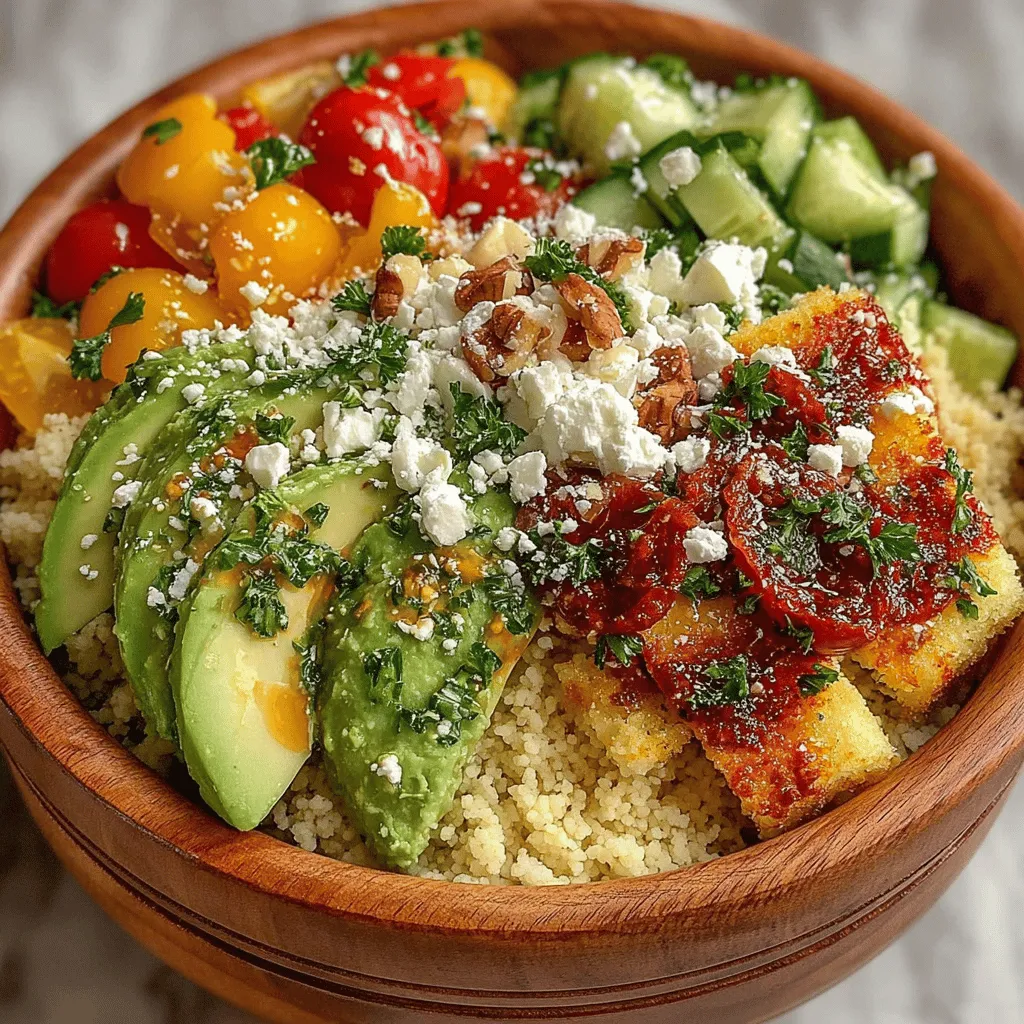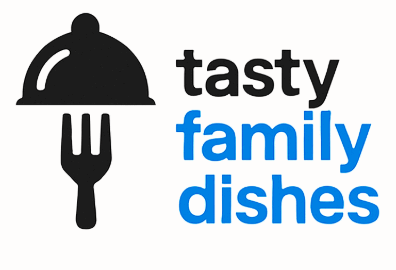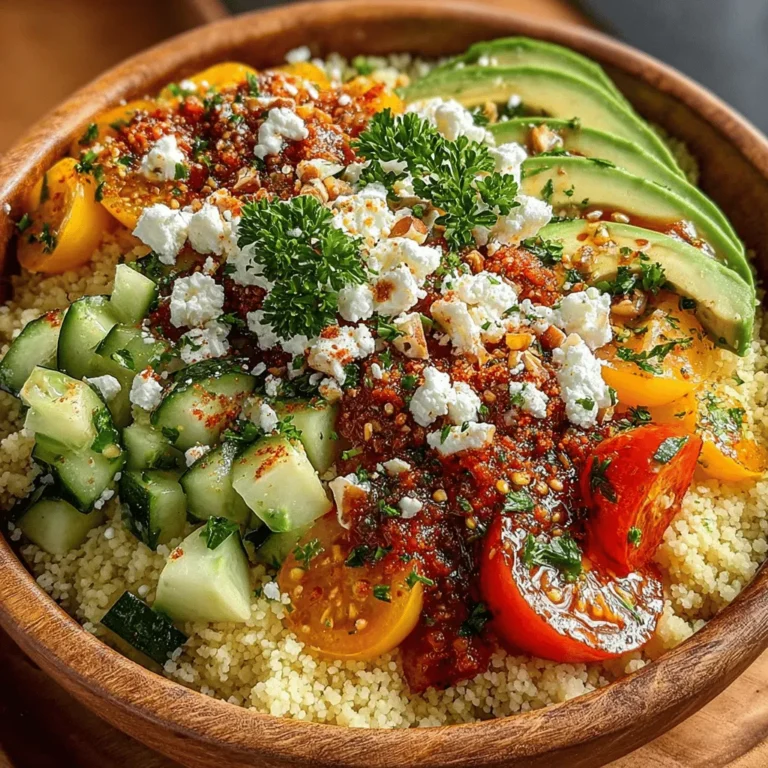Introduction to No-Cook Couscous Lunch Bowls
In a world where busy schedules often dictate our meal choices, the search for quick, nutritious, and delicious recipes is more pertinent than ever. Enter the No-Cook Couscous Lunch Bowls—a perfect solution for those looking to prepare a wholesome meal without turning on the stove. These vibrant, colorful bowls combine the wholesome goodness of couscous with fresh vegetables, protein-rich chickpeas, and a zesty dressing. Ideal for meal prep, a quick lunch at work, or a light dinner, these bowls are not only easy to make but also packed with flavor and nutrients.
Whether you’re a busy professional, a student, or just someone who values the convenience of a healthy meal, the No-Cook Couscous Lunch Bowls offer a refreshing take on what a satisfying meal can be. This recipe requires minimal effort while maximizing freshness and taste, making it a go-to option for anyone looking to balance convenience with nutrition. Let’s dive into the details of this delightful recipe that promises to elevate your lunchtime experience.
Understanding Couscous: A Versatile Grain
Before we delve into the specifics of preparing the No-Cook Couscous Lunch Bowls, it’s essential to understand the star ingredient: couscous. Couscous is not just a simple grain; it carries a rich history and a wealth of nutritional benefits that make it an ideal base for various dishes.
Exploring the Origins of Couscous
Couscous is a traditional North African dish made from semolina wheat, often served as a staple alongside stews and vegetables. Its origins date back to the Berber people of Morocco, where it has been enjoyed for centuries. Couscous is made by steaming small granules of semolina, resulting in a light and fluffy texture that absorbs flavors beautifully. Over the years, it has transcended cultural boundaries and found its way into many culinary traditions around the globe, making it a beloved ingredient in Mediterranean, Middle Eastern, and even contemporary Western cuisines.
Highlighting the Nutritional Benefits of Couscous
Nutritionally, couscous is a powerhouse. It is a source of complex carbohydrates that provide sustained energy, making it an excellent choice for lunch or dinner. Whole grain varieties of couscous offer additional fiber, which aids in digestion and promotes a feeling of fullness. Couscous is also low in fat and contains essential vitamins and minerals, including B vitamins, iron, and magnesium. This makes it an appealing option for anyone looking to maintain a balanced diet without sacrificing flavor.
Understanding the Different Types of Couscous Available
When selecting couscous for your No-Cook Couscous Lunch Bowls, it’s important to note that there are several types available. The most common varieties include:
– Regular Couscous: The standard form, typically made from refined wheat, cooks quickly and is widely available.
– Whole Wheat Couscous: A healthier option made from whole wheat flour, offering more fiber and nutrients than its refined counterpart.
– Israeli Couscous (Pearl Couscous): Larger and chewier than traditional couscous, this variety requires a slightly different cooking method. Though it can be used in no-cook recipes, it might need to be prepped differently.
– Gluten-Free Couscous: Made from alternative grains like corn or rice, this option is perfect for those with gluten sensitivities.
For the No-Cook Couscous Lunch Bowls, regular or whole wheat couscous works best due to their light texture and ability to soak up the flavors of the dressing and vegetables.
Ingredients Breakdown: Fresh and Flavorful Components
Now that we’ve explored the background of couscous, let’s take a closer look at the key ingredients that make up the No-Cook Couscous Lunch Bowls. Each component plays a vital role in creating a balanced and flavorful dish.
Couscous: The Base of the Dish
Couscous serves as the main base for these lunch bowls, providing a neutral yet satisfying foundation. When prepared correctly, it will be light and fluffy, ready to absorb all the delicious flavors from the fresh ingredients and dressing.
Fresh Vegetables: Cucumber, Cherry Tomatoes, Bell Pepper, Red Onion
A medley of fresh vegetables adds color, crunch, and essential nutrients to the dish. Here’s a breakdown of the key vegetables:
– Cucumber: Refreshing and hydrating, cucumbers are low in calories and high in water content, making them perfect for a light meal.
– Cherry Tomatoes: These bite-sized bursts of flavor offer sweetness and acidity, enhancing the overall taste of the bowl.
– Bell Pepper: Available in a variety of colors, bell peppers add a sweet crunch and are rich in vitamins A and C.
– Red Onion: With its sharp flavor, red onion adds depth and a bit of bite, perfectly balancing the other ingredients.
Protein Source: Chickpeas
Chickpeas, or garbanzo beans, are a fantastic source of plant-based protein and fiber. They not only contribute to the dish’s heartiness but also provide essential nutrients like iron and folate. Whether you use canned chickpeas or cook them from scratch, they add a satisfying texture and earthy flavor to the bowl.
Flavor Enhancers: Olive Oil, Lemon Juice, Parsley, and Feta Cheese
To elevate the dish further, a zesty dressing is essential. The combination of olive oil and lemon juice serves as a base, providing healthy fats and a bright acidity that ties all the ingredients together. Fresh parsley adds a burst of herbal flavor, while crumbled feta cheese contributes creaminess and a salty kick. The combination of these flavor enhancers ensures that every bite is bursting with taste.
Optional Ingredients: Avocado, Nuts, or Seeds for Added Texture
For those looking to customize their No-Cook Couscous Lunch Bowls even further, consider adding optional ingredients like avocado, nuts, or seeds. Avocado brings creaminess and healthy fats, while nuts or seeds add a delightful crunch and additional protein. These optional ingredients can also enhance the nutritional profile of the dish, making it even more satisfying.
Step-by-Step Guide to Preparing No-Cook Couscous Lunch Bowls
Preparing No-Cook Couscous Lunch Bowls is an efficient process that allows you to create a healthy meal in just a few steps. Here’s a guide to help you navigate the preparation timeline for maximum efficiency.
Preparing the Couscous: Techniques for Perfect Fluffiness
While this is a no-cook recipe, it’s important to prepare the couscous properly to achieve the perfect texture. Since couscous can absorb water quickly, simply place it in a bowl and pour over boiling water or vegetable broth. Cover it with a lid or plastic wrap and let it sit for about 5-10 minutes until it absorbs the liquid. Once it’s fluffy, use a fork to gently fluff the grains, ensuring that they don’t clump together.
Chopping Vegetables: Tips for Quick and Efficient Chopping
Next, prepare the vegetables. Begin by washing and drying all fresh produce. To chop efficiently, gather all your vegetables and use a sharp knife for clean cuts. Cut the cucumber, cherry tomatoes, and bell pepper into bite-sized pieces, ensuring uniformity for even distribution in the bowl. For the red onion, thinly slice it to prevent overwhelming bites. Having all your vegetables prepped and ready will save you time and ensure a quick assembly.
Mixing It All Together: How to Ensure Even Distribution of Flavors
Once your couscous and vegetables are prepared, it’s time to mix everything together. In a large mixing bowl, combine the fluffed couscous with the chopped vegetables and chickpeas. Drizzle the olive oil and lemon juice over the mixture, and sprinkle in the chopped parsley and crumbled feta. Gently toss everything together, ensuring that the dressing coats all the ingredients evenly. This is crucial for flavor, as it allows the couscous to absorb the delicious elements from the veggies and dressing.
By following these initial steps to prepare your No-Cook Couscous Lunch Bowls, you will create a base that is not only satisfying but also bursting with nutrition and flavor. This dish’s versatility makes it easy to customize according to your preferences, ensuring a delightful meal every time. In the next part of this article, we will delve deeper into additional variations and tips to enhance your No-Cook Couscous Lunch Bowls experience.

Dressing the Bowl: The Importance of a Balanced Dressing
A successful no-cook couscous lunch bowl hinges not just on the ingredients but also on the dressing that ties everything together. A balanced dressing enhances the flavors of your bowl while adding an extra layer of nutrition.
Crafting the Perfect Dressing
When creating a dressing for your couscous bowl, consider a blend of acidity, sweetness, and richness. A classic vinaigrette made from olive oil, lemon juice, salt, and pepper works beautifully. The olive oil provides healthy fats, while the lemon juice adds brightness and helps to balance the dish.
Suggested Dressing Recipe:
– Ingredients:
– 3 tablespoons extra virgin olive oil
– 2 tablespoons freshly squeezed lemon juice
– 1 teaspoon Dijon mustard (optional for kick)
– Salt and pepper to taste
– A pinch of dried herbs (like oregano or basil)
– Instructions:
1. In a small bowl or jar, combine the olive oil, lemon juice, mustard, salt, pepper, and herbs.
2. Whisk or shake well until the dressing is emulsified.
3. Drizzle over your assembled couscous bowl just before serving for a fresh burst of flavor.
Nutritional Benefits of No-Cook Couscous Lunch Bowls
This no-cook couscous lunch bowl is not only convenient but also packed with nutritional benefits, making it an excellent choice for a wholesome meal.
Couscous as a Source of Carbohydrates
Couscous is a type of pasta made from semolina wheat, providing complex carbohydrates that deliver sustained energy. It’s a quick-cooking grain (or pasta) that can be prepared in minutes, making it ideal for busy lunches.
The Role of Vegetables in Providing Vitamins and Minerals
The vibrant vegetables in your couscous bowl contribute a myriad of vitamins and minerals. For instance, bell peppers are rich in vitamin C, while cucumbers provide hydration and fiber. Leafy greens like spinach or kale offer iron and calcium, essential for overall health.
Chickpeas as a Plant-Based Protein Source
Chickpeas are a powerhouse of plant-based protein and fiber, helping you feel full longer. They also provide a good amount of folate, iron, and magnesium, making them a staple ingredient in healthy diets.
Healthy Fats from Olive Oil and Optional Toppings
The inclusion of olive oil not only enhances flavor but adds healthy monounsaturated fats. If you choose to add toppings like avocado, nuts, or seeds, you’ll further boost the nutritional profile of your meal with additional healthy fats, vitamins, and minerals.
Customization Options: Making It Your Own
One of the best aspects of the no-cook couscous lunch bowl is its versatility. You can easily customize this recipe to suit your taste or dietary preferences.
Vegetarian and Vegan Substitutions
This bowl is inherently vegetarian and can easily be made vegan by ensuring that all toppings and dressings are free from animal products. For example, swap out any dairy-based toppings for nut cheeses or simply increase the number of vegetables.
Seasonal Vegetable Swaps for Freshness
Utilizing seasonal vegetables not only enhances the freshness of your dish but also supports local agriculture. In winter, consider roasted vegetables like sweet potatoes or Brussels sprouts. In summer, fresh tomatoes, zucchini, or corn can add vibrant flavors and textures.
Creative Toppings: Nuts, Seeds, and Additional Proteins
Elevate your couscous bowl with creative toppings like toasted almonds, sunflower seeds, or pumpkin seeds for crunch. If you’re looking to add more protein, consider adding grilled chicken, tofu, or a hard-boiled egg, depending on your dietary preferences.
Storage and Serving Suggestions for No-Cook Couscous Lunch Bowls
To enjoy your no-cook couscous lunch bowls at their best, it’s essential to understand proper storage and serving techniques.
Best Practices for Storing the Bowls
When preparing your lunch bowls in advance, store components separately if possible to maintain freshness. Keep the couscous, vegetables, and dressing in separate containers until you’re ready to eat. This prevents sogginess and ensures the best texture.
Meal Prep Containers: Choosing the Right Ones
Opt for airtight, BPA-free containers that are easy to transport. Glass containers work well for meal prep as they are durable, microwave-safe, and do not retain odors. Choose containers that are divided, allowing you to keep different components separate.
Serving Suggestions: Creative Ways to Present the Dish
Presentation can enhance the dining experience. Consider serving your no-cook couscous bowl in a wide, shallow bowl to showcase the colorful ingredients. Garnish with fresh herbs, a sprinkle of feta cheese, or a drizzle of dressing just before serving to elevate the visual appeal.
Enjoying Leftovers: How to Maintain Freshness and Flavor
If you have leftovers, enjoy them within 3-4 days for optimal freshness. When reheating, you can add a splash of extra dressing or lemon juice to freshen the flavors. If serving cold, consider adding a bit more olive oil or seasoning to enhance the taste.
Conclusion: Embracing Simplicity with No-Cook Couscous Lunch Bowls
As we wrap up our exploration of no-cook couscous lunch bowls, it’s clear that this recipe is a game-changer for busy individuals seeking healthy meal options. With its ease of preparation, vibrant ingredients, and versatility, this dish not only satisfies hunger but also nourishes the body.
Whether you choose to enjoy it cold or at room temperature, this no-cook recipe serves as a testament to the idea that simplicity can indeed lead to delicious and fulfilling meals. Embrace this delightful dish in your weekly meal plan, and discover how it can transform your lunchtime routine. With a few simple ingredients and a touch of creativity, you can enjoy a meal that is as nutritious as it is delicious.


